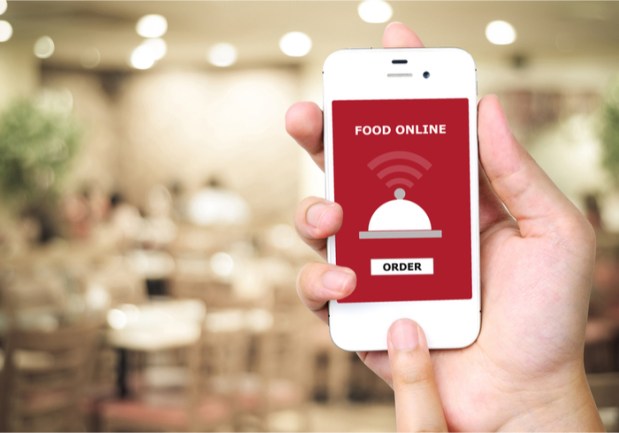QSRs Serve Diners With Mobile Innovation

Diners are embracing connected devices in their everyday lives, especially when it comes to food. To order meals from their favorite quick-service restaurants (QSR), they are turning to their smartphones, smart speakers and other tools. QSRs are taking note of this preference by making deals to improve their ordering options, with mobile innovation leading the initiatives.
Yum! Brands, for instance, teamed up with GrubHub for delivery in a deal reported earlier this year: the QSR company bought a stake in the delivery aggregator and planned to provide online ordering and delivery for its Taco Bell and KFC brands. As of October, Restaurant Business reported that 30 percent of the chains’ domestic restaurants had delivery as they continue to bring the option to their locations.
Yum! Brands’ move comes as consumer interest in order-ahead technology is growing: only 38 percent of consumers had used mobile or connected devices at least once to place food orders until 2015, according to the PYMNTS Commerce Connected Playbook. Now, 40 percent of consumers regularly use a mobile order-ahead app or online platform, up from just 11 percent three years ago.
As a whole, QSRs are a booming industry: American consumers will have spent more than $255 billion at them by the end of 2018, which is an increase of close to 4 percent on a year-over-year basis. At the same time, the number of workers employed grew by 3 percent from last year and the number of QSR stores grew by 2 percent. QSRs from Subway and Dunkin’ to McDonald’s are all tapping into this growth with the help of connected technology through loyalty programs, mobile ordering and kiosks, among other initiatives:
The total number of Subway locations in the U.S. — more than any other QSR chain — is 25,098 stores. And, in February, the company drove innovation through a new loyalty offering that gives customers tokens that eventually mature into dollars. The program, which is called Subway MyWay Rewards, was set to launch in March and was to be available at 28,500 restaurants. With the new program, customers earn four tokens for every dollar they spend at the chain. In order to receive a sandwich valued at $6, they would need 600 tokens. At the same time, the chain was also updating its mobile app to go along with the new program. Subway’s Chief Digital Officer Carissa Ganelli said in a press release at the time, “we know time and money are important to our guests. It’s important to us that we deliver a seamless, convenient experience to help our customers get what they want when they want it — and what they want is our delicious, nutritious and affordable food.”
The decrease in the number of independent QSRs operating in the U.S. this year is 2 percent. However, there are homegrown food delivery services taking hold, which may help local restaurants gain exposure. In Richmond, Virginia, for example, Chop Chop allows diners to choose from a menu of 50 to 60 restaurants for delivery. Because the service is local and has close relationships, companies such as Chop Chop can work with restaurant owners and talk with them about their needs, what makes them unique and what they can do in terms of getting the word out about their establishments. Chop Chop Owner Chris Chandler told PYMNTS.com in a previous interview, “we’re there to market for them to help them grow.” The idea behind the marketing efforts of companies like Chop Chop is not just to increase the number of deliveries; they also seek to help restaurants increase their overall brand awareness with social media and guerrilla marketing to help restaurants expand their markets.
The size of the QSR industry in the U.S. is projected to be $256B by 2020. And there have recently been some large deals in the space. In September, it was reported that Inspire Brands would acquire Sonic for approximately $2.3 billion. Sonic’s Board of Directors unanimously approved the agreement and the price represents a premium of approximately 19 percent per share to Sonic’s closing stock price of $43.50 per share on September 24. Sonic CEO J. Clifford Hudson said in a press release at the time, “this transaction delivers significant, immediate and certain value to Sonic shareholders, and the private ownership structure will provide important benefits to our guests, franchisees and employees.” He also said that the brand’s franchisees are involved in technology, product and marketing planning.
The total sales growth for American restaurants in August was 1.8 percent. For Dunkin’, system-wide sales grew by 4.6 percent over the third quarter, as comparable store sales increased by 1.3 percent that time. In an earnings conference call with analysts in late October, Dunkin’ Brands Chief Executive Officer and President David Hoffmann noted “solid growth” across its beverage portfolio, as well as a new snacking platform that resulted in the strongest afternoon performance in two years. The executive also said the company has more than 60 new and remodeled NextGen stores across the country, which exceeds the original target of 50 stores that it shared at an investor day in February. The new 2,200-square-foot concept stores, according to past reports, seek to accommodate mobile order-ahead by separating out the drive-thru lanes and making it easier for mobile customers to pick up.
The total number of eateries in the U.S. as of Spring 2018 was 660,755 restaurants. And those eateries are rolling out innovative digital technologies such as kiosks. McDonald’s, for instance, plans to add adding these self-service stations at a rate of 1,000 U.S. stores per quarter for the next eight to nine quarters. McDonald’s CEO Steve Easterbrook said, according to CNBC in June, that customers could only use the drive-through or counter service two years ago. Now, Easterbrook said, according to the outlet, “we’re introducing many options. They can order through mobile, they can come curbside and we’ll run it out, as well as the existing traditional ways. You can pay in different ways and customize your food in different ways.”
For Yum! Brands, its efforts come as fast food chains have increased their appetite for delivery. McDonald’s, for example, has rolled out the option to 5,000 of its approximately 14,000 U.S. stores. And customers typically spend more when they order delivery, according to McDonald’s, suggesting that the technology could help bolster sales for establishments in the QSR space.
